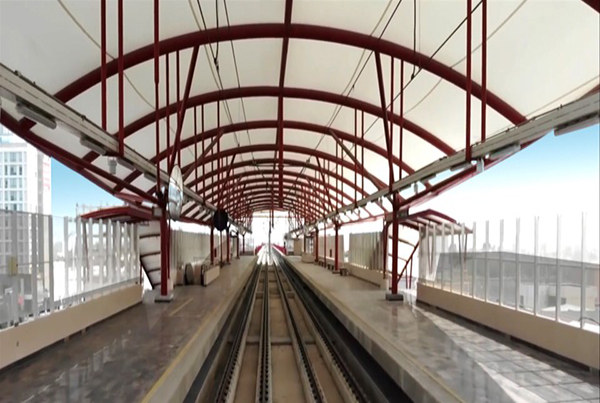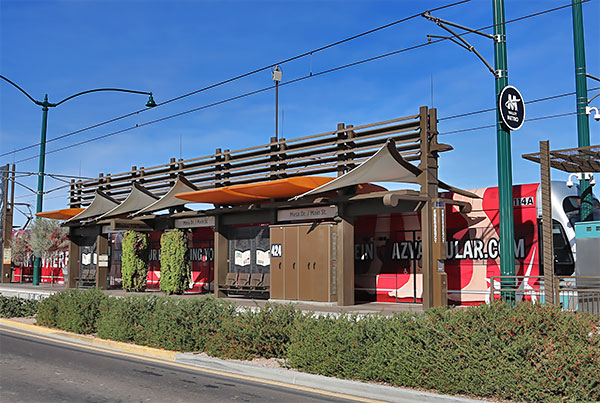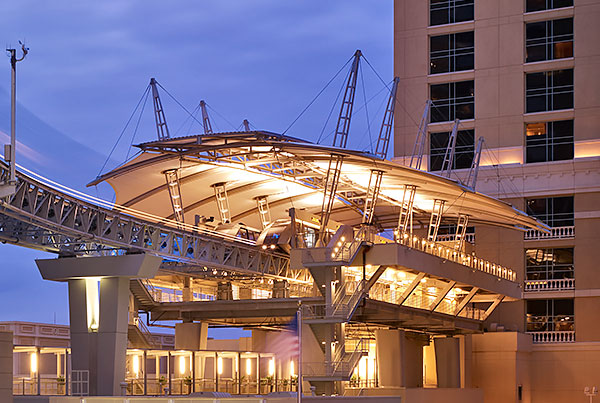Structure Type: Mast-supported canopy
Project Scope:
Project Size: 38,280 sqft
Material: PTFE
Location: Las Vegas, NV
Completion Date: 2009
Market Segment: Infrastructure
Owner: MGM Mirage Design Group
General Contractor: Clark-Thor Construction
Architect: Gensler of NV
Engineer: Saiful Bouquet
CityCenter, an unprecedented urban metropolis on the Las Vegas Strip with Gold LEED® certifications, is a joint venture between MGM MIRAGE and Infinity World Development Corporation, a subsidiary of Dubai World. It took 9,000 construction workers nearly four years to turn the 68-acre site into a metropolis. There is enough steel in the project to erect 10 Eiffel Towers and enough concrete to build a four-foot wide sidewalk stretching from Las Vegas to New York City and back again. Even by Vegas standards, the place is huge.
With a price tag of $8.5 billion, CityCenter has become the largest privately-funded project in U.S. history. CityCenter is made up of six separate buildings. The centerpiece is the Aria Casino which features over 4,000 guest suites that are said to be some of the most technologically sophisticated rooms in the country – if not the world. The Veer Towers, Mandarin Oriental Las Vegas, Vdara Hotel & Spa, Harmon, and Crystals Retail & Entertainment round out CityCenter. Along with being the biggest project on the Strip, CityCenter, one of the largest employers, has created approximately 12,000 new jobs in a city where the unemployment rate is close to 13 percent. With its focus on art, the center hosts work from some of the world’s most renowned sculpture artists. Perhaps one of the most artistic pieces, however, is the custom tensile fabric structures from Enclos Tensile Structures and Gensler Architects that form the centerpiece of the light rail station terminal.
Weaving between CityCenter’s buildings, rather than along the strip, and connecting to the Monte Carlo, Bellagio, and Crystals Retail Center, the people movers (there are actually two structures – one at the Bellagio and one at the Monte Carlo) were designed to facilitate the dynamic movement of residents and guests. The structures’ designer, Sanjeev Tankha, of Enclos Tensile Structures, comments on the “light and airy” concept for the structure stating, “We worked very closely with the architectural design team in the conceptual stage to make the structure visually as light as possible in order to give it the appearance of clouds floating over the station.” The “floating cloud” PTFE fabric canopy has approximately 19,140 square feet (1,778 square meters) in surface area and was designed with catenary edges and large compression ring openings penetrating the tilted truss masts.
The truss in the center of the structure effectively creates 2 levels which allow for cross circulation and eases the air pressure beneath where the passengers load. Project Manager Tim Sullivan of Gensler Architects notes that, “the somewhat oval-shaped design of the fabric panels gives the structure a sense of motion.” The center truss and the steel posts that are at the base of the structure were designed to mimic the look of the APM guideway that the tram runs on. The challenges during the installation of the project were considerable in light of the structural fabric “floating” at over 100 feet above the ground.
One of the major challenges to overcome was that access to and around the site itself was very limited and proved to be difficult due to the ongoing construction of the entire CityCenter metropolis, which was occurring simultaneously. In addition, the project is located on the very busy downtown Las Vegas Strip. The construction crews were extremely limited in their ability to store materials at the site and were unable to be given a laydown area below the platforms for pre-lift assembly work; a separate staging area at some distance away from the main construction site was utilized. As a result of the limited site access, all work was done from the elevated platforms. With the platforms being elevated, equipment such as man-lifts had to be lifted by crane to the platform, thus committing them for the duration of the project. At the same time, larger cranes had to be placed at the platform bases with enough crane boom and capacity to set in one location and reach over the entire platform for steel erection. Due to time, access, and other issues, it was necessary to build the two rail station structures with staggered yet overlapping schedules, with the Monte Carlo completed first and, soon after, the Bellagio. The Monte Carlo structure is located adjacent to the hotel’s pool which meant that access for the cranes and other equipment was limited even further.
Enclos Tensile Structures Senior Vice President of Project Management, Garry Becker, notes that, “our original plan called for sub-assembling the roof in sections on the ground and lifting them up into position where they could be connected and suspended by their individual permanent suspension cables, but we ultimately determined that we would be in a much better position if we assembled the structure in the air in pieces. The nature of the structure’s design also posed some unique challenges in that what was being built was a very dynamic structure.” Becker adds, ”With the entire roof structure being suspended from ten masts by cables and the masts sitting on pinned bases, every time a new steel section was added to the roof, we had movement and a resulting change in the geometry of the structure. We decided to use shoring towers under the center of the roof to allow us to erect the steel without having to allow for these dynamic movements.” The structures became fully stable once all the steel sections and connections were complete. Then the shoring towers could be lowered and removed, allowing the suspension cables to take the load and the roof structure to take shape.
Enclos Tensile Structures President Claude Centner sums it up, noting that, “This is a very innovative structure in terms of both design and construction, which seems appropriate for a project located in one of the world’s most impressive new metropolises – we are extremely proud of these structures which serve as great examples of what the current fabric structure industry is capable of creating.” The client for the rail station, MGM Mirage, was looking for an attractive and affordable solution for their tram station needs and is pleased with the results. At night, when the canopies are lit, it creates a glowing effect that can be seen from the many hotel rooms above and gives MGM a unique focal point and another stand-out feature to a world-class project. The project won an Outstanding Achievement Award in 2010, as presented each year by the Industrial Fabrics Association International (IFAI).










